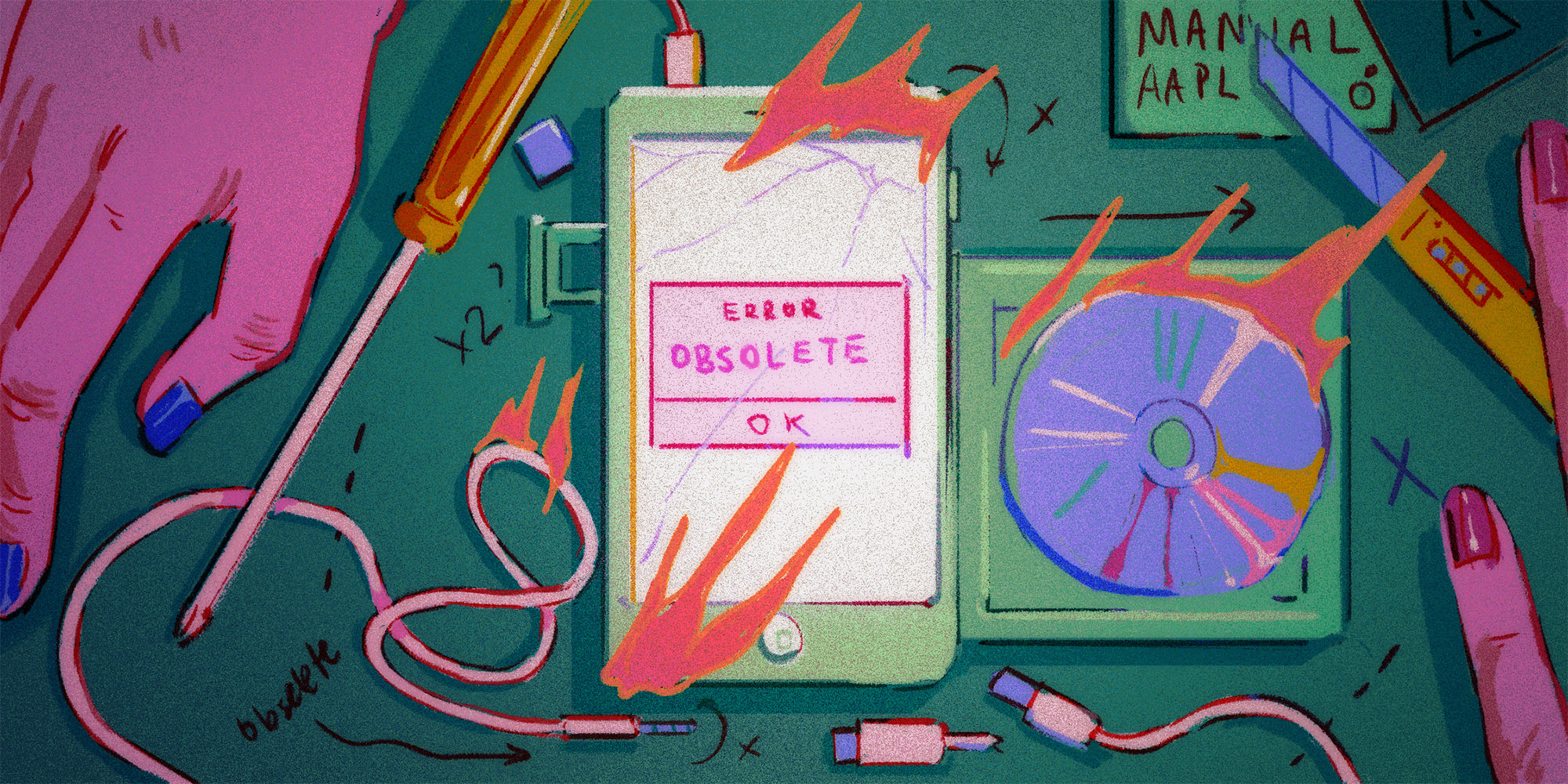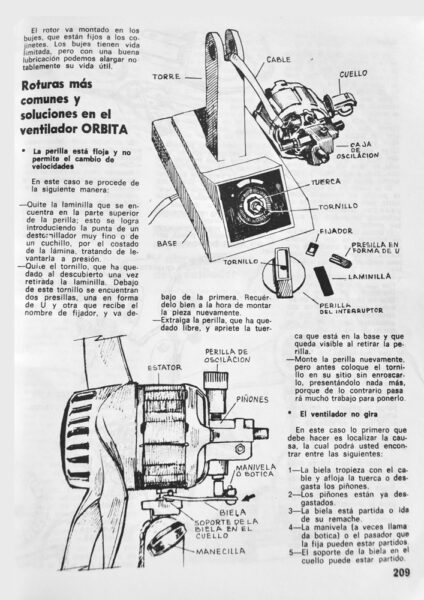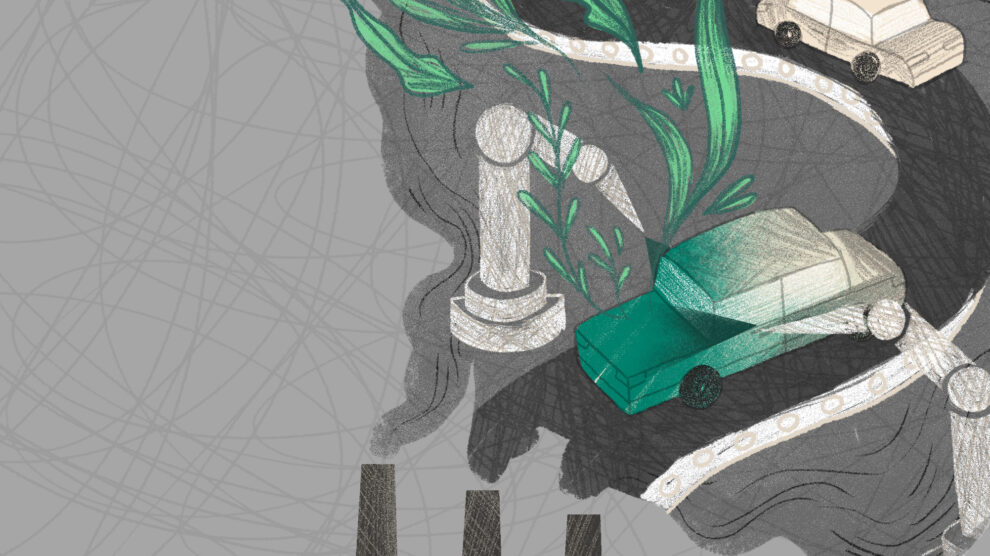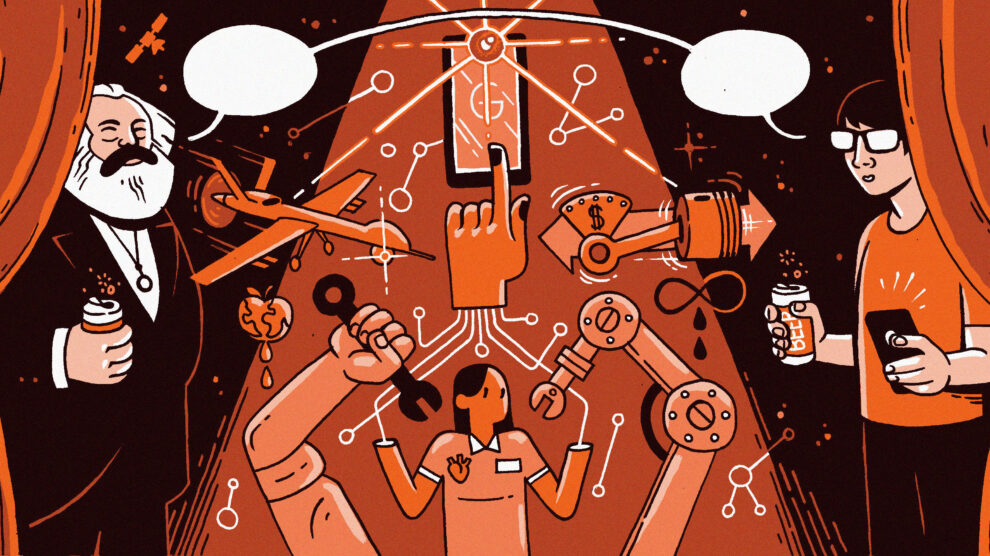Opening This Article Voids Warranty
By Harun Šiljak
Volume 24, number 2, Don’t Be Evil

There is a red line in repair nowadays. When I patch my socks, I am considered a sweet eccentric with romantic ideals about repair, little respect for my time, and a poor grasp of the economics of sock manufacturing. However, when I try fixing an old industrial robot arm, I become “a freelance subversive.”1 When the robot’s control system manufacturer sold me a controller, they attempted to stop me from interacting with its insides by writing “this robot will not work with any other controller, and some vague and unenforceable consequences follow if attempted otherwise” in legalese. Some manufacturers prevent user interventions by strategically placing stickers warning that opening and looking inside their product is against the rules—but the truth is, the stickers are often against the law.2 When the manufacturers are not busy printing stickers, they prepare lawsuits, design complex circuitry and mechanisms that actively resist repair, and lobby for fortification of the patent system.3 My focus here is the role of repair in affluent consumer markets; however, the vital role of repair in other parts of the world is not forgotten. Only in linking repair efforts in the Global North and South can a potent strategy for sustainable repair emerge in the face of modern capitalism and climate change.
Repair is not an auxiliary, optional part of the economy. Repair is care, at every stage of the supply chain, and at every scale. Those in dire need of repair for their devices are, just like Terry Pratchett’s Theory of Economic Injustice predicts, in the crosshairs of widening economic inequality.4 Already-impoverished consumers are encouraged to buy ever-newer products (and other planned obsolescence mechanisms have co-evolved with the boom of overproduction for the Global North). These products are notoriously hard to repair by design and require repeated purchases, exposing the long-term scheme of the manufacturers. Mineral extraction necessary for the manufacture of new hi-tech devices inflicts death and immiseration on surrounding populations.5 A community that sees no value to repair is a community that cannot respond to the crisis of capitalism, and is merely its hostage. Repair, as an act of reclaiming technology, is ongoing in the Global North and South with complementary driving forces and problems.
The consumers in the North, often trying to manage small businesses (farms, mechanical shops, small manufacture), are seen as an easy target for a dependent relationship with manufacturers of irreparable machinery. Consumers of the Global South are superfluous to these supply chains altogether, except when their lands are targets for the extraction of raw materials. In the South, repair has long been a critical skill and a dominant path to technical reproduction. In such a setting, it is not surprising to see power structures (states, big local enterprises, political agents) try to put repair under control, and often monopoly, mimicking the anti-repair tendencies of the multinational companies with aggressive legislation and rigid conditions for repair.6 Fundamentally, repair evolves alongside technology, allowing one to go back, fix mistakes, acknowledge shortcomings, and overcome them; as such it is a societal mechanism as well, one of healing interpersonal relationships.7
Repair is care, at every stage of the supply chain, and at every scale.
We all know a friend who loves and uses their old-school scooter for work every day; everything on that scooter can be fixed, often with basic tools. The electronics-aided devices that came later, they will insist, are not yours anymore. You cannot fix them; the point of contact between human and machine has been removed. Any erstwhile repairable part is wrapped tightly into numerous layers of hardware and software obfuscation, led by two complementary ideas: one, that repair is not important; the other, that repair is harmful for the business plan. It is by the action of these forces that the right to repair has been replaced with the call to throw away. Thousands of discarded bicycles from bike-sharing schemes give a shocking visual of mechanical, repairable devices banned from repair. The supply chain evolved to profit from a short life cycle,8 and society and the government are left to deal with the fallout rather than the businesses.9 These bikes are like socks—if someone decides to repair them, they are just irrational economic agents in the eye of the supply chain. There, the repair is not disabled but disincentivized. It becomes disruptive if repair of such devices becomes a collective movement, an act of disobedience. Again, this is dependent on the economic context: the idea that something as functionally repairable as a bicycle is irrational to repair is particular to an affluent consumer market. In a different market, where the bicycle repair (or any other repair) is the default option, and where the bicycle is discarded only if significantly disfigured in an accident, irrationality is on the side of not repairing.
A classic strategy of anti-repair design is avoiding modularity. If the parts of the device are strategically bundled together so that failure of one part requires replacement of a whole unit, it is not “repair” anymore. While it happens with mechanical components as well, the electronic version of this strategy is worthy of closer examination. Unlike a gearbox whose miniaturization still results in an assemblage of separate gears that might be smaller and harder to replace, miniaturization in electronics was driven by manufacture of monolithic semiconductor structures. Control systems that have previously been implemented with, for example, a collection of discrete transistors and diodes (basic electronic components that are easily replaceable) have been revamped as embedded systems: for the same functionality they now use a microchip with software running on it. Access to the software is not provided. Access to the chip itself is not provided as it is commonly “globbed” (covered with a black blob of epoxy). On top of this, the manufacturer takes precautions to prevent you from replacing the entire controller with a different, customized controller on your own. Here I return to the robotic arm: what kind of a controller do you want such a mechanism to have? The odds are that the same arm might be deployed in a myriad of different settings and scenarios, and needs tweaking of the controller. The “body without organs” controller under the blob of epoxy offers no modularity, no chance to expand, reduce, or in any other way customize inputs, outputs, or processing capabilities. The individual components that might be at a higher risk of damage (e.g. transistors) don’t exist anymore, so every failure takes the entire block of silicon down with it. And finally, if product support is discontinued, the manufacturer goes out of business, or chooses to change the business model into selling a service rather than a product, the controller is expected to become an unusable brick. To make things worse, by making non-standard interfaces with mechanics and/or placing restrictive licenses on its software, the brick is supposed to be irreplaceable, hence rendering the entire robotic arm unusable (even if the mechanics are perfectly sound).
The loss of repairability is not a consequence of technological progress or increasing complexity—it should arguably be the opposite. Complex systems science pioneer W. Brian Arthur explains the two primary mechanisms of improving a technology: “internal replacement,” or changing the existing parts; and “structural deepening,” which means adding new components.10 Neither of these require that new parts and components cannot be modular, replaceable, and repairable. Complexity, in fact, is all about modularity and heterogeneity and can be an argument in favor of repair. The concepts of internal replacement and structural deepening, if anything, are the philosophy of repair as a creative process. New parts or mechanisms that come from repair contribute to an invention: potential new applications of the device, a new approach to manufacturing, and personalization of the item. A creatively repaired device is where the social network merges with the technological one. However, that is not in the interests of the manufacturing lobby: this network is one of capital accumulation.
The other aforementioned strategy of disabling repair is the legal one. To keep this grip of capital on the technology and knowledge of manufacturing and repair, the opponents of repair create the illusion of illegality: Looking under the hood should be taboo, understanding how things work should be perceived as illegal, and the concept of patents and protection of intellectual property should be regurgitated as respect for science and protecting the world from anarchy. Big manufacturers such as Apple also grasp at other legal straws such as privacy concerns.11
Bogus legal barriers run against the basic principles of science and engineering. Take, for example, the concept of reverse engineering. Finding out how a piece of hardware or software works by observing its inputs and outputs is an essential part of repair in modern technological systems. Often portrayed as illegal, this activity does not go against trade secrets laws. Instead, it becomes an issue concerning terms and conditions agreed to by user and manufacturer.12 Among legal contracts, “terms and conditions” represent a world of their own, with clauses that are often void, unenforceable, or plain illegal.13 The “opening box voids warranty” stickers mentioned earlier are a blatant example, but not the only one. Through lobbying, manufacturers erect new legal barriers where previously there had been none: when the Unitron Mac 512, a Brazilian clone of the Apple Macintosh was developed in the mid-eighties, it infringed no laws in Brazil. Only after heavy lobbying from Apple and threats of sanctions from the US government did the Brazilian government introduce a completely new “software law” to stop the sale of the reverse-engineered Macintosh.14
With the advent of 3D printing, one of its most mentioned use cases became printing replacement parts—for furniture, machines, even living bodies.15 It opened a space for imagining new property relationships. A piece of plastic could be in constant flux, changing its shape depending on the current use it is required for. Machine X needs a part, and plastic assumes the appropriate form: machine Y needs a differently shaped part, and plastic changes shape with a new print. The user does not yet own a part, but the knowledge of printing it and a piece of raw plastic (even ownership of the printer is not necessary; it could be a communal service).16 Capital is not amused: with no monopoly over the means of production, its power crumbles. In 3D printing, this means that legal protection of the status quo would necessitate the establishment of “illegal geometries,” shapes that these pieces of plastic are not allowed to assume.
Disaster capitalism rebuilds the supply chains, crushes repair initiatives, and exacerbates economic oppression through monopolies.
Even in times of crisis such as the current COVID-19 pandemic, when availability of critical components can dictate life or death, firms and governments persist in their protection of monopoly and claims of intellectual property. The supply chains of critical components failed early in the pandemic: an Italian hospital ran out of oxygen valves, the supplier could not provide them, and access to blueprints was denied, citing EU regulations.17 3D printing the valves (for $1) solved the problem, in the process opening a broad discussion on intellectual property in a deadly global crisis.18
Disruption of supply chains in emergencies leaves behind a vacuum whose sequential responses are instructive. The immediate response is to fill it with repair, improvisation, and mutual aid from the community. The next stage is where institutions and capital come into play. Disaster capitalism rebuilds the supply chains, crushes repair initiatives (except for the rare cases where repair works in capital’s favor: the military-industrial complex will allow soldiers to repair their guns on the battlefield!19), and exacerbate economic oppression through monopolies.20
An alternative model may instead utilize state initiatives to stimulate repair initiatives and support the flow of common knowledge. A notable example of this is the publication of two books by the government of Cuba in the early nineties. Faced with a difficult sanctions-induced economic crisis, the state widely distributed El libro de la familia (The Book for the Family), a compendium of practical knowledge useful in a state of emergency.21 A follow-up publication called Con nuestros propios esfuerzos (With Our Own Efforts) was a similar, if more complete compendium of practical advice, recipes, and instructions, this time with ideas sourced from the populace.22 This bidirectional exchange of knowledge between institutions and individuals could be a model for radical communal technological development: innovations from one source are modulated by the other according to their particular interests, with the prospect of convergence on a sustainable culture of communal innovation.

Close to 2,000 local governments worldwide have declared states of climate emergency so far.23 It is hard to deny that we face a planetary crisis that is already disrupting social and economic structures. Predominantly capitalist in nature, these structures will follow the pattern of disaster capitalism, crushing communal repair initiatives whenever possible and maintaining entrenched attitudes of extractivism, resource hoarding, and imperialism. Though firms and governments may couch their activities in greenwashing language, their strategies and goals remain unchanged: maximization of resource extraction, restriction of access, and monopolization. At the moment of writing this article, the International Energy Agency proffers the claim that “[t]he world won’t be able to tackle the climate crisis unless there is a sharp increase in the supply of metals required to produce electric cars, solar panels, wind turbines and other clean energy technologies.”24 Created in the aftermath of the early-seventies oil crisis at the suggestion of Henry Kissinger, IEA carries the politics of twentieth-century resource exploitation over into twenty-first-century disaster capitalism. Be it more oil or more coltan, the push for more resources is a cornerstone of the status quo.
Such an approach is in sharp contrast to a paradigm shift offered by repair. What a mass turn to the principle of repair means is captured by Naomi Klein in On Fire: “we will not emerge from this crisis without a shift in worldview at every level, a transformation to an ethos of care and repair. Repairing the land. Repairing our stuff. Fearlessly repairing our relationships within our countries and between them.”25
If you liked this article, please consider subscribing or purchasing print or digital versions of our magazine. You can also support us by becoming a Patreon donor.
Notes
- Accusation against freelance repairman Harry Tuttle in Brazil, directed by Terry Gilliam. Embassy International Pictures, Brazil Productions, 1985.
- Matthew Gault, “FTC Gives Sony, Microsoft, and Nintendo 30 Days to Get Rid of Illegal Warranty-Void-if-Removed Stickers,” Vice, May 1, 2018, https://www.vice.com/en/article/xw7b3z/warranty-void-if-removed-stickers-sony-microsoft-nintendo-ftc-letters.
- David Rodríguez Goyes, “Corporate lobbying and criminalisation,” Crime, Law and Social Change 69, no. 3 (2018): 401-419.
- As famously described in: Terry Pratchett, Men at Arms (New York: Random House, 2008), 40
- Sy Taffel, “Towards an Ethical Electronics? Ecologies of Congolese Conflict Minerals,” Westminster Papers in Communication and Culture 10, no. 1 (2015).
- Steven J. Jackson, Alex Pompe, and Gabriel Krieshok, “Repair Worlds: Maintenance, Repair, and ICT for Development in Rural Namibia,” in Proceedings of the ACM 2012 Conference on Computer Supported Cooperative Work, CSCW ’12 (New York, NY, USA: Association for Computing Machinery, 2012), 107–16.
- “A man goes to his uncle’s to fix a broken water heater, having no idea it will reunite their torn family and awaken painful, but priceless memories.” Synopsis of Days and Hours, directed by Pjer Žalica, Refresh, 2004.
- Masha Borak, “Remember China’s bike sharing boom? Those bikes are now scrap metal,” South China Morning Post, November 15, 2018, https://www.scmp.com/abacus/tech/article/3028976/remember-chinas-bike-sharing-boom-those-bikes-are-now-scrap-metal.
- Ji Siqi, “What Happens to Discarded Bikes from China’s Sharing Boom? Taxpayers Pay to Clear 25 Million of Them from Bicycle Graveyards,” South China Morning Post, October 2, 2020, https://www.scmp.com/business/china-business/article/3103908/what-happens-discarded-bikes-chinas-sharing-boom-taxpayers.
- W. Brian Arthur, The Nature of Technology (The Free Press, 1999), 131–38.
- Sam Metz, “Big Tech and Independent Shops Clash Over ‘Right to Repair,’” Associated Press, March 30, 2021.
- Electronic Frontiers Foundation (EFF): Coders’ Rights Project Reverse Engineering FAQ.
- Meirav Furth-Matzkin, “On the Unexpected Use of Unenforceable Contract Terms: Evidence from the Residential Rental Market.” Journal of Legal Analysis 9, no. 1 (2017): 1-49.
- I. da C. Marques, “Cloning Computers: From Rights of Possession to Rights of Creation,” Science as Culture 14, no. 2 (2005): 139–160, https://doi.org/10.1080/09505430500110887.
- Adam Greenfield, Radical Technologies: The Design of Everyday Life (Verso Books, 2017), 100.
- Greenfield, Radical Technologies, 90.
- Dana Mahr and Sascha Dickel, “Rethinking Intellectual Property Rights and Commons-Based Peer Production in Times of Crisis: The Case of COVID-19 and 3D Printed Medical Devices,” Journal of Intellectual Property Law & Practice 15, no. 9 (2020): 711-717.
- In 2021 we see this happen again, now with the vaccines—once again, it is the question of cheap means of production being available. Namely, the new mRNA vaccines are produced with technology cheaper than that of classical vaccine manufacturing. See Zoltán Kis et al., “Rapid Development and Deployment of Highvolume Vaccines for Pandemic Response,” Journal of Advanced Manufacturing and Processing 2, no. 3 (2020): e10060. With the ever changing landscape of production capabilities, the primary way for the dominant players to keep the supply chains under the economic and political control remains in administering the right to manufacture. It is not rare to tie it with racism and colonial mentality: the Global South, they will claim, has no ability to produce the vaccines even if “we allow them”. The Irish vice-prime minister (Tánaiste) said “very few countries in the global south have the infrastructural know-how or the materials to make those vaccines and there’s no point in giving somebody a recipe if they don’t have the kitchen or the cooking skills or the ingredients.” See Simon Carswell, Marie O’Halloran, “Government and big pharma face clash on Covid-19 vaccine patent waiver”, The Irish Times, May 6, 2021, https://www.irishtimes.com/news/health/government-and-big-pharma-face-clash-on-covid-19-vaccine-patent-waiver-1.4557184).
- This is a thought originating from my early childhood. Not too surprisingly for a war-torn country, I stumbled upon a few strange cartoon books published by the army about repair and maintenance of personal firearms in the warfield. Unlike the other manuals we had around the house that were “instructions for use” and written in a highly technical language, these were accessible, and repair-oriented. See Donald W. Srull, D. Jerry Wallick, and Bruce J. Kaplan, “Battle Damage Repair: An Effective Force Multiplier,” Logistics Management Institute, Bethesda MD, 1991.
- Naomi Klein, The Shock Doctrine: The Rise of Disaster Capitalism (Penguin Books, 2007), 6.
- El Libro de la Familia, Ed. José Cazañas Reyes (Verde Olivo, 1991), 199, available from the Technological Disobedience Archive: https://drive.google.com/file/d/10A4JHEvFiqrYkgwHteKil4B3G0RkwRsG/view.
- Con Nuestros Propios Esfuerzos (Verde Olivo, 1992), available from the Technological Disobedience Archive: https://drive.google.com/file/d/1qjTxwgoIXPEh3CUrI6yVzBIYvuYZa47I/view.
- “Climate Emergency Declaration and Mobilisation in Action,” Cedamia, accessed May 7, 2021, https://www.cedamia.org/global/.
- International Energy Agency, “The Role of Critical Minerals in Clean Energy Transitions,” World Energy Outlook Special Report, May, 2021, https://www.iea.org/reports/the-role-of-critical-minerals-in-clean-energy-transitions
- Naomi Klein, On Fire (Simon & Schuster, 2019), 270.





